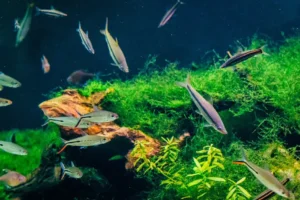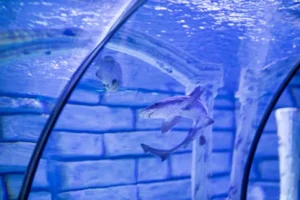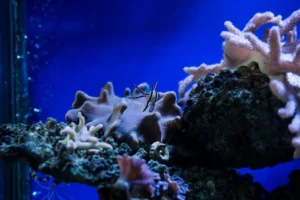
What Species Thrive in a Saltwater Fishtank?

Creating a saltwater fishtank can be an exciting endeavor, but choosing the right species to fill it is crucial. Not all marine life is suitable for aquarium life, and understanding which species thrive will help you maintain a beautiful and harmonious underwater environment. In this guide, we’ll explore the various species that are ideal for saltwater fishtanks.
Step 1: Assess Your Tank’s Size and Environment
Before selecting species, evaluate the size of your tank and the current conditions such as water quality and temperature.
Every saltwater fishtank has unique constraints, so whether you have a small 10-gallon tank or a larger 75-gallon setup, the species you choose will directly impact the overall health and happiness of your aquatic community. Larger tanks often allow for a greater variety of species, but overcrowding can lead to stress and aggression.
It’s important to also consider the tank’s environment. The substrate, rocks, and plants you choose can create shelter and hideaways that mimic natural habitats, making it easier for certain species to thrive. For example, some fish prefer rocky areas for breeding while others need open water space to swim freely.
Step 2: Explore Compatible Fish Species
Research fish that are known to thrive in saltwater environments like clownfish, damselfish, and gobies. Pay special attention to their size and behavior.
Clownfish are a popular choice for beginners, known for their vibrant colors and friendly demeanor. These fish thrive in pairs and often form symbiotic relationships with anemones, providing not just companionship but a unique dynamic to your fishtank.
On the other hand, damselfish are hardy and quite territorial, making them excellent for established tanks. They can be a bit aggressive, especially during breeding seasons, so ensure you consider tankmates carefully.
Another great species to consider is the goby. These small fish are generally peaceful and make good candidates for community tanks. Plus, they come in various species, offering a range of colors and shapes to choose from. Just remember, their size and compatibility play essential roles in the success of your ichthyological ensemble.
Step 3: Consider Invertebrates for Variety
Incorporating invertebrates such as shrimp, crabs, and snails can add diversity and help maintain tank health through algae control.
Shrimp, particularly cleaner shrimp, are not only fascinating to watch but they also provide essential cleaning services for your fish. They help remove parasites and dead skin, maintaining a healthy ecosystem within your fishtank. Plus, their colorful presence adds vivid life to the underwater scenery.
Crabs can also serve as both an interesting visual element and a useful tank inhabitant. While some species might be too aggressive or territorial, others, like hermit crabs, are generally peaceful and contribute to the cleanliness of your tank by scavenging for leftover food.
Don’t overlook snails! They may seem simple, but snails are incredible algae eaters. They’ll help keep your aquarium clean and can thrive in various conditions. Moreover, they add an extra layer of complexity to your tank’s ecosystem, enriching the environment for the fish you’ve chosen.
Step 4: Choose Corals and Anemones Wisely
If you’re interested in a reef setup, select hardy corals and anemones that are easier to care for and compatible with your fish selection.
Soft corals, like leather corals, tend to be more forgiving to beginners than stony corals. They require less light and are generally easier to maintain, yet they can add both color and movement to your tank.
Anemones are visually stunning and often attract clownfish, creating a delightful symbiotic relationship. However, ensure you research the specific species of anemone, as some require more advanced care and specific water conditions to thrive.
When selecting corals, consider the lighting and water flow your tank can provide. Some corals flourish under strong lighting, while others prefer shaded areas, so match your choices to your existing environment to maximize their growth potential.
Step 5: Maintain Proper Tank Care
Regular maintenance, including water changes and monitoring levels, is vital to keep your chosen species thriving in your saltwater fishtank.
Changing 10-15% of the water weekly can help maintain water quality and remove toxins. This simple action can make a world of difference for your aquatic friends. Just be mindful to match the temperature and salinity of the new water to that of the tank.
In addition, regularly testing water parameters such as pH, nitrate, and ammonia levels ensures that your fish and invertebrates remain healthy. If any of these levels go awry, it can have adverse effects on your entire aquarium community.
Engaging in routine tank care also includes cleaning algae accumulations and filtering systems to maintain crystal-clear water. When the environment remains clean and stable, your beautiful fishtank will flourish, showcasing a vibrant aquatic life for all to enjoy.
Final Thoughts on Choosing Saltwater Species
By carefully selecting the right species for your saltwater fishtank, you can create a vibrant and thriving underwater ecosystem. Remember to consider each species’ compatibility and environmental needs to ensure a healthy tank. Happy fishkeeping!
Latest Post


12 Exotic Saltwater Fish Every Enthusiast Should Know About

Why Are Saltwater Systems Preferred for Luxury Fish Tanks?

Choosing the Right Inhabitants for Your Saltwater Aquariums
Create Your Underwater paradise today
Start your journey to a stunning saltwater aquarium today. Our experts at Mikalyzed Exotic Aquariums are here to bring your vision to life.

